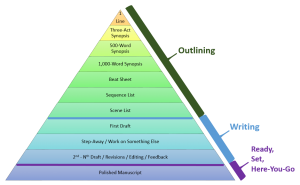Some writers are “seat-of-your-pants” scribes, others are “top-down” organizers, and many fall anywhere in between. I’m squarely in the top-down category whereas my brother’s a self-described puker, which is something somewhat more extreme than seat-of-your-pants writing.
What follows is by no means solely (or even largely; or even much at all; OK, I created the image) a product of my own mind. I’ve spent a lot (a lot) of time reading books and internet sources, both as entertainment and craft-knowledge-building. There are many interpretations for every step of the below, and other elements abound which I haven’t incorporated into my personal methodology. Anyhoot, here is how I envision my particular top-down process. I start with The 1 Line and move down. Each point builds on the one which precedes it, growing larger and larger in scope until I have, I hope, a polished manuscript.
Of course, I expect my characters to revolt along the way. When they do I’m prepared to go back and revise the prior building blocks as needed.
Outlining Stage
- 1 Line – I know loglines are screenwriting-oriented. I understand some agents and publishers hate them. Nonetheless, I feel that being able to boil a manuscript down to one 25-words-or-less line which results in someone asking hear more is priceless. Plus, I might someday need to coherently convey my story in seconds. I intend to be prepared.
- Three-Act Synopsis – Essentially, a 250-word synopsis describing the main points of the story, covering all three acts (do make sure to include the ending.) Hit the necessary highlights: main character, what s/he wants, the obstacle, and the stakes. Keep characters to a minimum. This, minus the ending, will be the jump-off point for the query letter. Third-person, present tense.
- 500-Word Synopsis – Expand that three-act synopsis into 500 words. Add in the decision-points, the changes which result, and be sure cover the entire story arc. Agents or Publishers might request this. Third-person, present tense.
- 1,000-Word Synopsis – Expand that 500-word synopsis even further. Add in more action, emotion, and style. It might be tempting to add in secondary characters and subplots at this point. Resist. Agents or Publishers might request this. Third-person, present tense.
- Beat Sheet – Expand that 1,000-word synopsis into the suggested beats. See Blake Snyder’s Save the Cat! for more info on beats.
- Sequence List – Expand each beat into sequences, one or more sequences per beat.
- Scene List – Each sequence contains one or more scenes, do that expansion. Create descriptive paragraphs delineating the action in each and every scene, using goal-conflict-disaster and reaction-dilemma-choice format. Each scene must move the story forward. Secondary characters and subplots start to come to life. As I understand it, this is rarely a requested item; think of it as the final outline. Third-person, present tense, or use the POV and tense that will be in the manuscript.
Writing Stage
- First Draft – Write the full first draft of the manuscript. Build on the scene list adding dialog, emotion, description, and, where needed, narrative summary. Avoid exposition.
- Step-Away – Set the first draft aside for a few weeks or months. Work on something else. Gain distance.
- 2nd – Nth Draft – Revise as needed. Get beta readers. Ask for feedback. Rework. Edit. Examine it all – from overall arc to every sentence, every word. Check grammar, spelling, and punctuation. Cut deeply and don’t forget to kill those darlings. Add substance where needed. Go back to the building blocks and ensure everything’s still in sync.
- First X pages – Time to query? No! Go back to the beginning. Agents might ask for the first x pages (often requested as part of the query) or x chapters. Prepare for that now, make sure the first 3-5 pages, first 50 pages, first 3 chapters are all as polished as they can be. Then take any changes made in those and carry them throughout the entire manuscript and back to the building blocks.
Ready, Set, Here-You-Go Stage
- Polished Manuscript – at the end of all the above lies the polished manuscript, ready for the acid test: will anyone want to read it? Now it’s time to start querying! Use that three-act synopsis, minus the ending, to guide the creation of the query letter – should be a piece of cake at this point. When the query results in a request for more, you’re all set to respond because you have it all in place. X chapters? Fabulous, here you go. A Synopsis? Awesome, here you go. A scene list? Happy to, here you go. The full manuscript? Excellent! Here you go.
